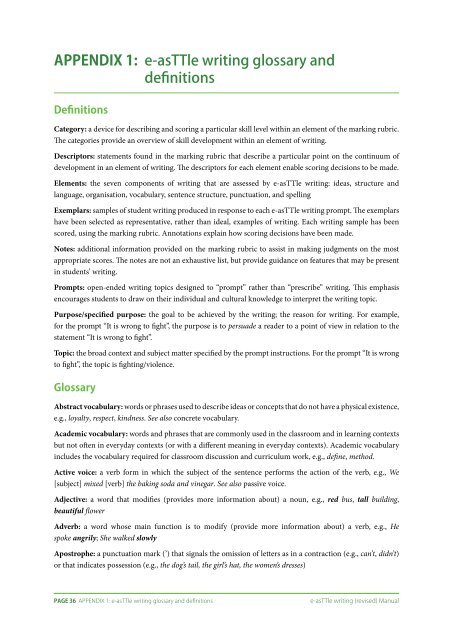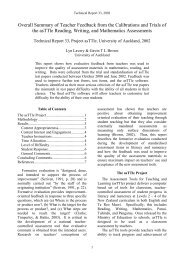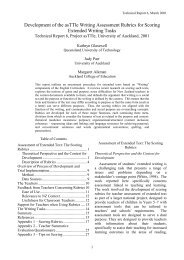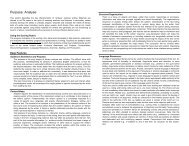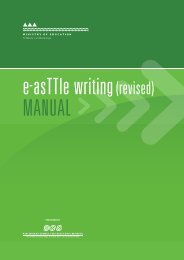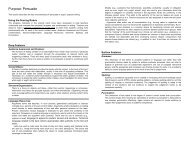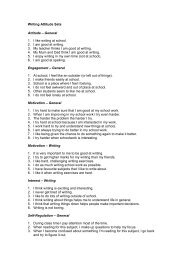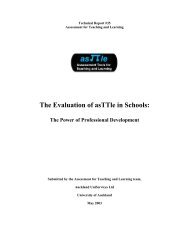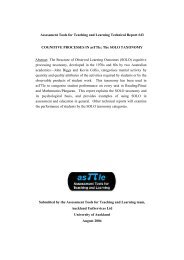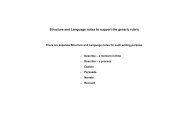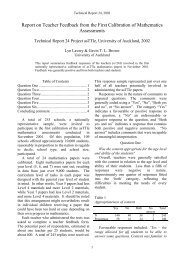e-asTTle writing (revised) Manual 2012.pdf
e-asTTle writing (revised) Manual 2012.pdf
e-asTTle writing (revised) Manual 2012.pdf
Create successful ePaper yourself
Turn your PDF publications into a flip-book with our unique Google optimized e-Paper software.
Appendix 1: e-<strong>asTTle</strong> <strong>writing</strong> glossary anddefinitionsDefinitionsCategory: a device for describing and scoring a particular skill level within an element of the marking rubric.The categories provide an overview of skill development within an element of <strong>writing</strong>.Descriptors: statements found in the marking rubric that describe a particular point on the continuum ofdevelopment in an element of <strong>writing</strong>. The descriptors for each element enable scoring decisions to be made.Elements: the seven components of <strong>writing</strong> that are assessed by e-<strong>asTTle</strong> <strong>writing</strong>: ideas, structure andlanguage, organisation, vocabulary, sentence structure, punctuation, and spellingExemplars: samples of student <strong>writing</strong> produced in response to each e-<strong>asTTle</strong> <strong>writing</strong> prompt. The exemplarshave been selected as representative, rather than ideal, examples of <strong>writing</strong>. Each <strong>writing</strong> sample has beenscored, using the marking rubric. Annotations explain how scoring decisions have been made.Notes: additional information provided on the marking rubric to assist in making judgments on the mostappropriate scores. The notes are not an exhaustive list, but provide guidance on features that may be presentin students’ <strong>writing</strong>.Prompts: open-ended <strong>writing</strong> topics designed to “prompt” rather than “prescribe” <strong>writing</strong>. This emphasisencourages students to draw on their individual and cultural knowledge to interpret the <strong>writing</strong> topic.Purpose/specified purpose: the goal to be achieved by the <strong>writing</strong>; the reason for <strong>writing</strong>. For example,for the prompt “It is wrong to fight”, the purpose is to persuade a reader to a point of view in relation to thestatement “It is wrong to fight”.Topic: the broad context and subject matter specified by the prompt instructions. For the prompt “It is wrongto fight”, the topic is fighting/violence.GlossaryAbstract vocabulary: words or phrases used to describe ideas or concepts that do not have a physical existence,e.g., loyalty, respect, kindness. See also concrete vocabulary.Academic vocabulary: words and phrases that are commonly used in the classroom and in learning contextsbut not often in everyday contexts (or with a different meaning in everyday contexts). Academic vocabularyincludes the vocabulary required for classroom discussion and curriculum work, e.g., define, method.Active voice: a verb form in which the subject of the sentence performs the action of the verb, e.g., We[subject] mixed [verb] the baking soda and vinegar. See also passive voice.Adjective: a word that modifies (provides more information about) a noun, e.g., red bus, tall building,beautiful flowerAdverb: a word whose main function is to modify (provide more information about) a verb, e.g., Hespoke angrily; She walked slowlyApostrophe: a punctuation mark (’) that signals the omission of letters as in a contraction (e.g., can’t, didn’t)or that indicates possession (e.g., the dog’s tail, the girl’s hat, the women’s dresses)Page 36 Appendix 1: e-<strong>asTTle</strong> <strong>writing</strong> glossary and definitionse-<strong>asTTle</strong> <strong>writing</strong> (<strong>revised</strong>) <strong>Manual</strong>


